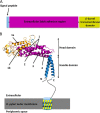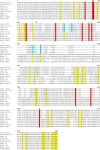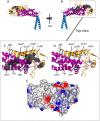The three-dimensional structure of the extracellular adhesion domain of the sialic acid-binding adhesin SabA from Helicobacter pylori
- PMID: 24375407
- PMCID: PMC3945300
- DOI: 10.1074/jbc.M113.513135
The three-dimensional structure of the extracellular adhesion domain of the sialic acid-binding adhesin SabA from Helicobacter pylori
Abstract
The gastric pathogen Helicobacter pylori is a major cause of acute chronic gastritis and the development of stomach and duodenal ulcers. Chronic infection furthermore predisposes to the development of gastric cancer. Crucial to H. pylori survival within the hostile environment of the digestive system are the adhesins SabA and BabA; these molecules belong to the same protein family and permit the bacteria to bind tightly to sugar moieties Lewis(B) and sialyl-Lewis(X), respectively, on the surface of epithelial cells lining the stomach and duodenum. To date, no representative SabA/BabA structure has been determined, hampering the development of strategies to eliminate persistent H. pylori infections that fail to respond to conventional therapy. Here, using x-ray crystallography, we show that the soluble extracellular adhesin domain of SabA shares distant similarity to the tetratricopeptide repeat fold family. The molecule broadly resembles a golf putter in shape, with the head region featuring a large cavity surrounded by loops that vary in sequence between different H. pylori strains. The N-terminal and C-terminal helices protrude at right angles from the head domain and together form a shaft that connects to a predicted outer membrane protein-like β-barrel trans-membrane domain. Using surface plasmon resonance, we were able to detect binding of the SabA adhesin domain to sialyl-Lewis(X) and Lewis(X) but not to Lewis(A), Lewis(B), or Lewis(Y). Substitution of the highly conserved glutamine residue 159 in the predicted ligand-binding pocket abrogates the binding of the SabA adhesin domain to sialyl-Lewis(X) and Lewis(X). Taken together, these data suggest that the adhesin domain of SabA is sufficient in isolation for specific ligand binding.
Keywords: Bacterial Adhesion; Carbohydrate Binding Protein; Helicobacter pylori; Membrane Proteins; Outer Membrane Protein; X-ray Crystallography.
Figures




Similar articles
-
Helicobacter pylori SabA adhesin in persistent infection and chronic inflammation.Science. 2002 Jul 26;297(5581):573-8. doi: 10.1126/science.1069076. Science. 2002. PMID: 12142529 Free PMC article.
-
Helicobacter pylori induces beta3GnT5 in human gastric cell lines, modulating expression of the SabA ligand sialyl-Lewis x.J Clin Invest. 2008 Jun;118(6):2325-36. doi: 10.1172/JCI34324. J Clin Invest. 2008. PMID: 18483624 Free PMC article.
-
Dynamics of Lewis b binding and sequence variation of the babA adhesin gene during chronic Helicobacter pylori infection in humans.mBio. 2014 Dec 16;5(6):e02281-14. doi: 10.1128/mBio.02281-14. mBio. 2014. PMID: 25516619 Free PMC article.
-
Helicobacter pylori adhesion to gastric epithelial cells is mediated by glycan receptors.Braz J Med Biol Res. 2010 Jul;43(7):611-8. doi: 10.1590/s0100-879x2010007500049. Epub 2010 Jun 7. Braz J Med Biol Res. 2010. PMID: 20521012 Review.
-
Increasing evidence of the role of Helicobacter pylori SabA in the pathogenesis of gastroduodenal disease.J Infect Dev Ctries. 2008 Jun 1;2(3):174-81. doi: 10.3855/jidc.259. J Infect Dev Ctries. 2008. PMID: 19738347 Free PMC article. Review.
Cited by
-
Antimicrobial resistance patterns and genetic elements associated with the antibiotic resistance of Helicobacter pylori strains from Shanghai.Gut Pathog. 2022 Mar 30;14(1):14. doi: 10.1186/s13099-022-00488-y. Gut Pathog. 2022. PMID: 35354484 Free PMC article.
-
The Effects of Hormones and Vaginal Microflora on the Glycome of the Female Genital Tract: Cervical-Vaginal Fluid.PLoS One. 2016 Jul 20;11(7):e0158687. doi: 10.1371/journal.pone.0158687. eCollection 2016. PLoS One. 2016. PMID: 27437931 Free PMC article.
-
Expression, purification and X-ray crystallographic analysis of the Helicobacter pylori blood group antigen-binding adhesin BabA.Acta Crystallogr F Struct Biol Commun. 2014 Dec 1;70(Pt 12):1631-5. doi: 10.1107/S2053230X14023188. Epub 2014 Nov 14. Acta Crystallogr F Struct Biol Commun. 2014. PMID: 25484214 Free PMC article.
-
Structural Insights into Polymorphic ABO Glycan Binding by Helicobacter pylori.Cell Host Microbe. 2016 Jan 13;19(1):55-66. doi: 10.1016/j.chom.2015.12.004. Cell Host Microbe. 2016. PMID: 26764597 Free PMC article.
-
Helicobacter pylori treatment in the post-antibiotics era-searching for new drug targets.Appl Microbiol Biotechnol. 2020 Dec;104(23):9891-9905. doi: 10.1007/s00253-020-10945-w. Epub 2020 Oct 14. Appl Microbiol Biotechnol. 2020. PMID: 33052519 Free PMC article. Review.
References
-
- Kuipers E. J., Michetti P. (2005) Bacteria and mucosal inflammation of the gut: Lessons from Helicobocter pylori. Helicobacter 10, 66–70 - PubMed
-
- Magalhães A., Reis C. A. (2010) Helicobacter pylori adhesion to gastric epithelial cells is mediated by glycan receptors. Braz. J. Med. Biol. Res. 43, 611–618 - PubMed
-
- Mahdavi J., Sondén B., Hurtig M., Olfat F. O., Forsberg L., Roche N., Angstrom J., Larsson T., Teneberg S., Karlsson K. A., Altraja S., Wadström T., Kersulyte D., Berg D. E., Dubois A., Petersson C., Magnusson K. E., Norberg T., Lindh F., Lundskog B. B., Arnqvist A., Hammarström L., Borén T. (2002) Helicobacter pylori SabA adhesin in persistent infection and chronic inflammation. Science 297, 573–578 - PMC - PubMed
-
- Aspholm M., Olfat F. O., Nordén J., Sondén B., Lundberg C., Sjöström R., Altraja S., Odenbreit S., Haas R., Wadström T., Engstrand L., Semino-Mora C., Liu H., Dubois A., Teneberg S., Arnqvist A., Borén T. (2006) SabA is the H. pylori hemagglutinin and is polymorphic in binding to sialylated glycans. PLoS Pathog. 2, e110. - PMC - PubMed
MeSH terms
Substances
LinkOut - more resources
Full Text Sources
Other Literature Sources

